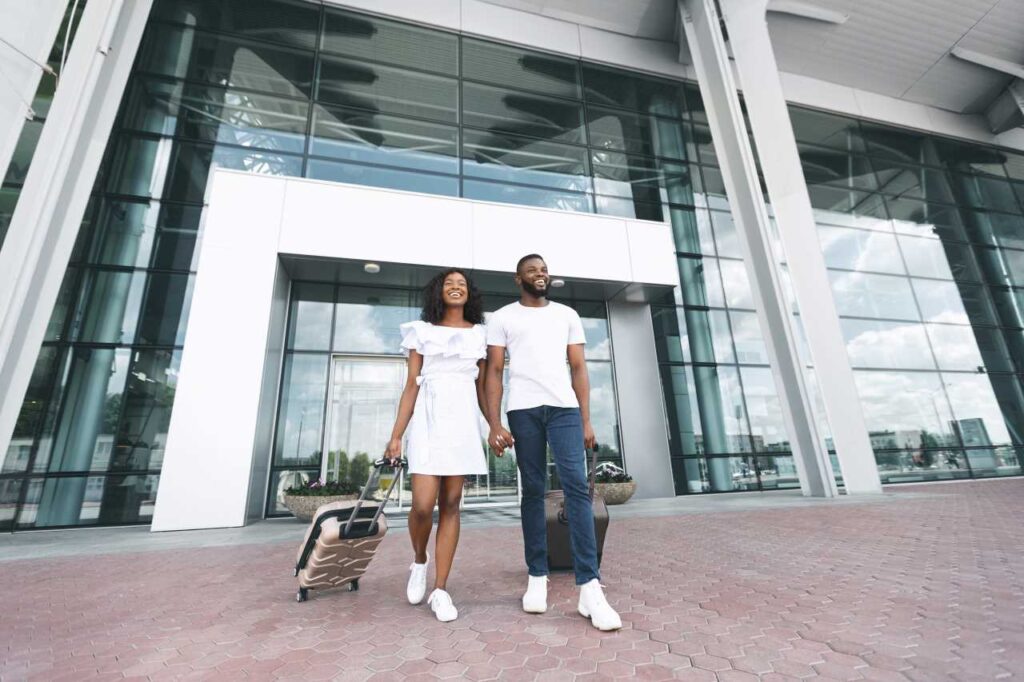Once your I-130 form (Petition for Alien Relative) has been approved, you might wonder if you can visit the United States before your green card is issued. The answer is no, unfortunately. If you are applying for a green card through a spouse or family member, you are generally required to remain outside the U.S. until your green card is officially approved.
Once your green card is approved, you will have 6 months to enter the United States. This is an important detail to keep in mind because traveling to the U.S. before your green card is issued could cause complications with your application.
Can I Bring an Interpreter to My Interview, Even If I Didn’t List One on the Application?
Yes, you can still bring an interpreter to your interview, even if you didn’t include one on your application. USCIS (U.S. Citizenship and Immigration Services) generally does not provide interpreters during interviews. If the officer believes you may struggle with English during the interview, they may reschedule it, or you can bring your interpreter to help.
To bring an interpreter, they must fill out a form called G-1256, Declaration for Interpreted USCIS Interview. This form is available at USCIS Field Offices, but it can also be completed in advance if you want to save time. The form essentially confirms that the interpreter will provide an accurate translation during your interview.
It’s always a good idea to bring an interpreter if you’re not confident with English, as it can help ensure that your responses are understood clearly and that you understand all questions correctly.
Applying for a B-2 Visitor Visa After I-130 Approval
Navigating the U.S. immigration system can be complex, especially when considering applying for a B-2 tourist visa after the approval of an I-130 petition. This guide outlines the application process, key considerations, potential outcomes, and challenges associated with applying for a B-2 visa in this context.
Once your I-130 petition is approved, you can apply for a B-2 visitor visa. However, it is crucial to demonstrate that your intention is solely to visit temporarily and not to immigrate. The application process involves:
- Completing Form DS-160: This online application form requires personal information and details about your travel plans.
- Paying the Visa Fee: A non-refundable fee must be paid before scheduling an interview.
- Scheduling a Visa Interview: Interviews are typically held at the U.S. consulate or embassy in your home country.
- Preparing Documentation: You will need to provide evidence of your ties to your home country, financial stability, and intent to return after your visit.
Key Factors Considered by the Consulate
When reviewing your B-2 visa application, consular officers will assess several factors:
- Intent: They will evaluate whether you genuinely plan to return home after your visit or if you have immigrant intent due to the approved I-130 petition.
- Strong Ties to Home Country: Evidence of employment, property ownership, family obligations, and community involvement can support your case.
- Previous Travel History: A history of compliance with U.S. immigration laws can positively influence the decision.
Possible Outcomes of Applying for a Visitor Visa
The outcomes of applying for a B-2 visa after I-130 approval can vary:
- Approval: If you successfully demonstrate non-immigrant intent and strong ties to your home country, your visa may be granted.
- Denial: The most common reason for denial is the presumption of immigrant intent due to the pending or approved I-130 petition.
- Additional Scrutiny: Even if granted, you may face heightened scrutiny at the port of entry by Customs and Border Protection (CBP) officers.
Challenges and Risks of Applying for a Tourist Visa
Suspicion from U.S. Consulate
The U.S. consulate may view your application with suspicion due to:
- The approved I-130 petition indicates an intention to immigrate.
- Concerns that you might overstay your visitor visa or adjust your status while in the U.S.
Risk of Visa Denial
The presumption of immigrant intent poses a significant risk when applying for a B-2 visa post-I-130 approval. Consular officers may deny your application if they believe you intend to immigrate rather than visit temporarily.
Addressing Immigration Authorities’ Concerns
To alleviate concerns from U.S. immigration authorities:
- Clearly State Your Intentions: During your interview, explicitly communicate that your visit is temporary and that you plan to return home.
- Provide Strong Evidence of Ties: Present documentation such as employment letters, property deeds, or family commitments that necessitate your return.
- Consult an Immigration Attorney: Having legal representation can help navigate complex issues related to immigrant intent.
Maintaining Strong Ties to Your Home Country
Definition of Strong Ties
“Strong ties” refer to connections that compel you to return to your home country after visiting the U.S., which may include:
- Employment commitments
- Family responsibilities
- Financial investments or property ownership
Demonstrating Intent to Return
To effectively demonstrate your intention to return home:
- Employment Verification: Provide letters from employers confirming your position and expected return date.
- Family Obligations: Documentation proving dependent family members who rely on you can strengthen your case.
- Financial Evidence: Bank statements or property ownership documents can show stability in your home country.
The Role of the Visa Waiver Program (VWP)
Eligibility for VWP After I-130 Approval
Individuals with an approved I-130 petition may still apply for entry under the Visa Waiver Program (VWP). However, this option carries its own risks:
- Limited Stay Duration: VWP allows stays up to 90 days without a visa but does not permit extensions or adjustments of status while in the U.S.
- Immigrant Intent Concerns: Similar scrutiny applies as with a B-2 visa; officers may suspect immigrant intent due to the pending petition.
Pros and Cons of Using VWP
Pros:
- Quick entry without needing a formal visa interview.
Cons:
- High risk of denial at entry if immigrant intent is suspected.
Adjusting Status in the U.S. After I-130 Approval
Adjustment of Status (AOS) allows individuals already in the U.S. on a valid visa (like B-2) to apply for permanent residency without leaving the country.
Process for AOS
- File Form I-485 once eligible.
- Attend biometric appointments and interviews as required.
Impact of Leaving the U.S.
Leaving the U.S. during AOS can jeopardize your application unless you have obtained advance parole prior to departure.
How to Avoid Complications While Visiting the U.S. After I-130 Approval
Visiting the United States after the approval of an I-130 petition can be complex due to immigration rules that require careful navigation to avoid overstaying or violating visa conditions. Here are key steps and considerations to ensure compliance and avoid complications during your visit.
Key Steps to Take
1. Understand Your Visa Options:
- If you have an approved I-130 petition, you may apply for a visitor visa (B1/B2). However, it is crucial to demonstrate that you do not have “immigrant intent,” meaning you plan to return to your home country after your visit.
2. Prepare Documentation:
- Gather evidence that supports your temporary visit, such as:
- A letter from your employer confirming your return date.
- Proof of ties to your home country (e.g., property ownership, family commitments).
- Financial statements showing you can support yourself during your stay.
3. Be Honest in Your Application:
- When applying for a visitor visa, answer all questions truthfully. Misrepresentation can affect your ability to obtain a green card in the future.
4. Comply with Entry Requirements:
- Upon arrival in the U.S., be prepared for scrutiny at the port of entry. Customs and Border Protection (CBP) officers will assess your admissibility based on your documentation and answers about your visit’s purpose.
Consulting with an Immigration Lawyer
Before traveling, consulting with an immigration lawyer is highly advisable. An attorney can provide tailored advice based on your specific situation and help you navigate the complexities of U.S. immigration laws. They can assist in preparing documentation and strategizing how to present your case effectively at the consulate and port of entry.
Alternatives if Your Visitor Visa Is Denied
If your application for a tourist visa is denied after I-130 approval, consider the following options:
1. Understand the Reason for Denial:
- Analyze the consulate’s reasons for denial. Common issues include failure to prove non-immigrant intent or insufficient ties to your home country.
2. Reapply for a Visa:
- If you believe you can address the concerns raised during your initial application, gather additional documentation and reapply for the visitor visa.
3. Explore Other Pathways:
- Look into other immigration options, such as applying for a different type of visa or adjusting your status once eligible.
Proceeding with Your Green Card Process
If entry into the U.S. is denied, continue pursuing your green card application through consular processing. This involves submitting Form DS-260 and attending an interview at a U.S. embassy or consulate abroad. Ensure all required documents are prepared, including medical examinations and financial records.
Legal Considerations and Expert Advice
Navigating U.S. immigration laws requires understanding legal nuances, especially when dealing with an approved I-130 petition.
Importance of Working with an Immigration Lawyer
An immigration attorney can provide invaluable assistance by:
- Clarifying legal requirements related to visitor visas while awaiting a green card.
- Helping you compile necessary documentation that demonstrates non-immigrant intent.
- Advising on best practices during interviews with consular officers or CBP agents.
Tips for Applying for a Visitor Visa While Waiting for Your Green Card
To enhance your chances of obtaining a visitor visa while waiting for your green card:
- Demonstrate Strong Ties: Provide ample evidence of commitments in your home country.
- Clearly Define Your Visit’s Purpose: Articulate why you intend to visit the U.S., whether for tourism or family events.
- Maintain Transparency: Be open about your pending I-130 petition but emphasize your intent to return home after visiting.
If your I-130 form has been approved, remember that you cannot visit the U.S. until your green card is approved. Once approved, you’ll have 6 months to enter the country. If you’re worried about communication during your interview, don’t hesitate to bring an interpreter. It’s better to be prepared, and USCIS is flexible in allowing you to bring the help you need to ensure a smooth and successful interview process.
How Law and Visas Can Help?
At Law and Visas, our team of expert immigration consultants is here to make your travel to the U.S. straightforward and successful. Whether you’re applying for a B-1/B-2 Visa or a K-3 Visa, we handle every step—from preparing your application to gathering the required documents.
Our Immigration Consultants and Lawyers ensure that your application meets the highest standards, with no details missed. We’ll also keep you informed throughout the process and coordinate with the immigration office or embassy on your behalf.
Law and Visas has a strong record of helping clients secure the visas/permits they need to visit the United States. You can call us today at +234 812 5505 986 to learn how we can help you.





